
When Carnoustie (ranked #26 in the world) is brought up in conversation, the discussion invariably turns to Jean Van de Velde and his meltdown in the 1999 Open Championship. It is too bad if that is the only impression many of us have of Carnoustie, because, despite the R & A allowing the course to be made ridiculously penal in 1999, it is an impressive course. Hopefully, the R & A has learned its lesson and for future Open Championships will let Carnoustie defend itself without trying to trick it up.
Carnoustie is an important and historic golf course. Originally laid out in 1840 by Allan Robertson, it is one of the oldest courses in the world. Subsequent changes were made by Old Tom Morris and James Braid, which is not too shabby a group. For years I organized a small golf trip to Great Britain or Ireland. We were frankly scared off of Carnoustie after seeing it on TV, so had not made it a priority to play. After a half dozen years, we finally put it on our itinerary, and having done so are now sorry that we waited so long.
If every golf course has a personality, Carnoustie is that of a working man. Looking over Carnoustie from the first tee and you are bound to be disappointed. Be patient, however, and you will be rewarded.
One of the key things that makes Carnoustie great is its variety and the selection of shots you are asked to hit. Another defining feature is the series of burns that run through the course. On six holes you have to navigate the most "Scottish" of burns in golf. The tenth is guarded by the unforgiving Barry Burn:
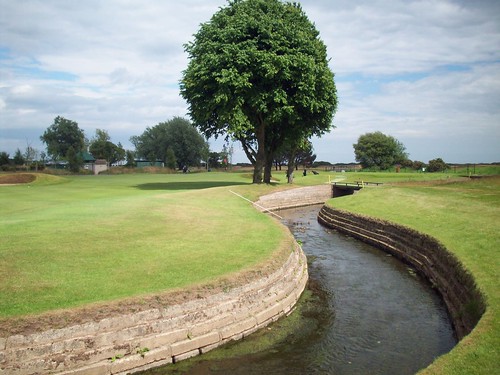
The Barry Burn snaking through the 10th hole
Carnoustie is an enigma. It is unquestionably one of the greatest golf courses in the world but not for the usual reasons. It has none of the beautiful scenery that Pebble Beach or Turnberry has; in fact, some of the views are almost industrial and gritty. It is not set directly on the water. It does not have the storied history of a Merion or a Muirfield. It does not have a Royal pedigree or a delightful clubhouse like Hoylake or Lytham and St. Annes. In fact, it has a bit of a dis-jointed history and has been the home of many different golfing societies and local clubs over the years. Carnoustie is a public links, roughly the equivalent of a Bethpage in the U.S. And, it has an inferiority complex to its neighbor across the bay - St. Andrews.
Yet, despite all these apparent shortcomings, there is a certain charm to the place. Carnoustie is not pretending to be something it is not. It doesn't put on any airs or try to be fancy or pretentious in any way. It deserves a high place in the world of golf because it has evolved into something great. It is pure golf.
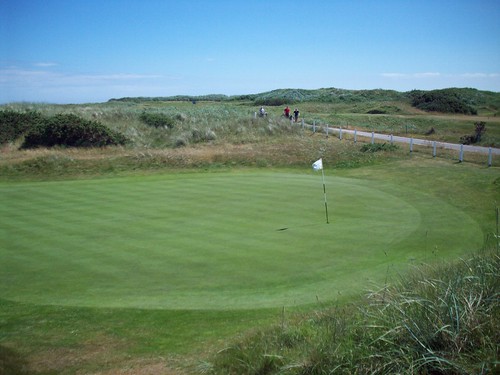
The second green, like many at Carnoustie, is set in a hollow
Every hole at Carnoustie fits perfectly into an overall mosaic. Unlike an out and back routing such as Troon, Carnoustie offers variety. There is a constant change in direction, which, given the strong wind that is frequently present, is important, so as not to wear a golfer down. The course follows the natural contours of the land. It has some short holes, some long ones, some holes that are easy to drive, others that are quite narrow. It rewards driving but is also a shot makers course. And, its caddies have the best wit and sense of dry humor in all of Scotland. The short commuter trains going by not far away with a stout whistle are charming, reminiscent of Prestwick.
The third hole is guarded by Jockie's Burn. It is a classic Carnoustie hole. How can you make a 355 yard hole difficult? Make the second shot a blind one and put a burn like this directly in front of the green:
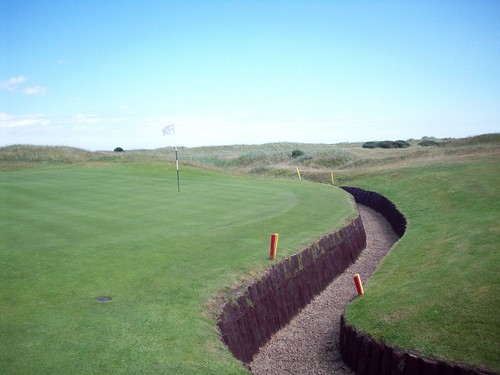
Jockie's Burn protecting the third green
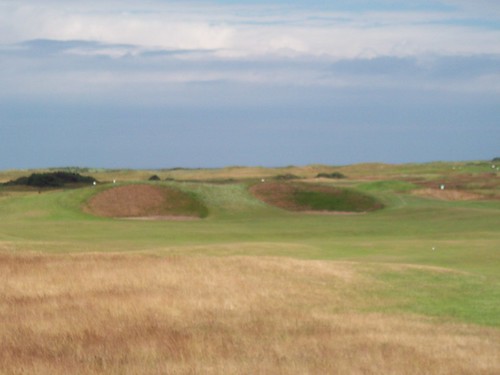
The fabulous 14th hole at Carnoustie, "Spectacles"
The fifteenth, "Lucky Slap", is a 459 par four that normally plays into a prevailing wind and features a narrow fairway to a green that sits between treacherous bunkers.
The sixteenth is an impossibly difficult 250 yard par three, whose green slopes back to front. During the 1968 Open Championship the hole played so long that Jack Nicklaus was the only player able to hit the ball past the pin. Tom Watson describes it as the hardest par three in golf and I won't disagree.
The seventeenth and eighteenth have the Barry Burn snaking through them. We all remember what the Barry Burn did to Jean Van de Velde on that dreadful Sunday in 1999. Ironically, the seventeenth hole is actually a more difficult hole. The seventeenth is aptly named "Island" and when you stand at the tee you quite literally think to yourself, "Where the F am I supposed to hit the ball?"
One of my favorite golf writers, Dell Leigh, had this to say about Carnoustie in 1925 and it still rings true today, "The burn meanders slyly about the course to trap the shots of the unskilled at several holes. But the course is all the better because of it. There is a great satisfaction in beating the burn, and beating it convincingly."
On seventeen you need to hit your tee shot to a very small landing area that exists between the snaking burn. It is equally as important to hit the ball both the correct distance and on the correct line. Most people hit into the burn. Your choice is whether to do it left or right. This is all difficult enough, add in the wind and you've got your hands full.
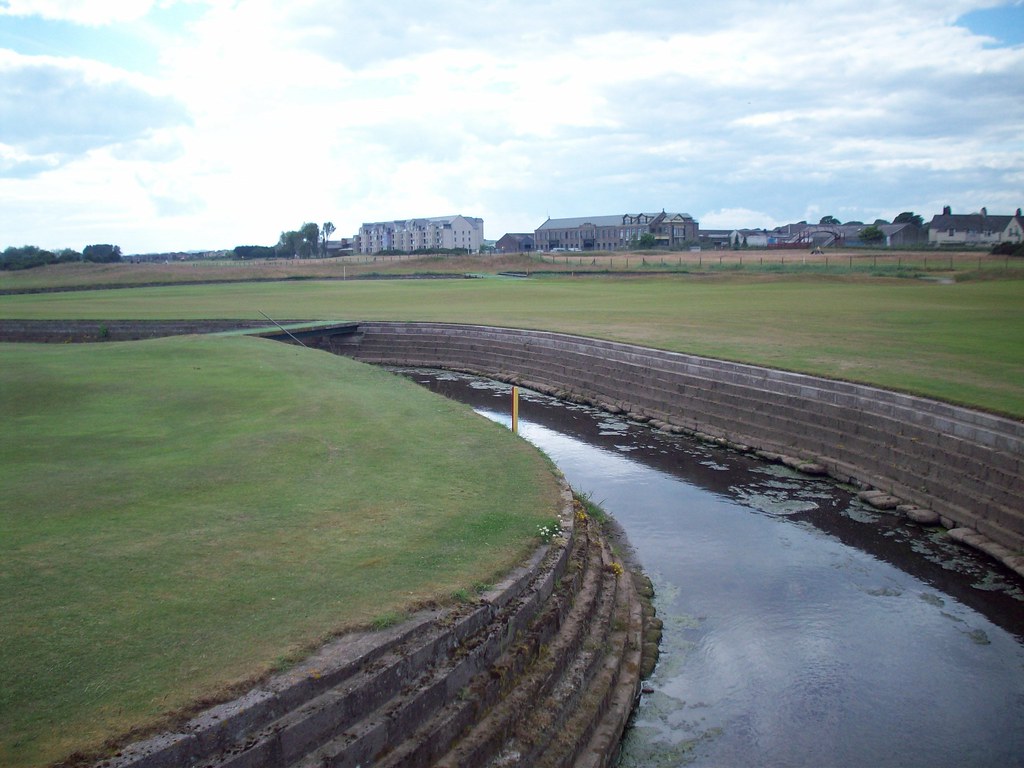
"Island", the wicked seventeenth hole at Carnoustie
The eighteenth repeats a lot of the characteristics of the seventeenth, but in the opposite wind direction, which completely change the dynamics. Also, the eighteenth has an out of bounds along the left side, so any tension in your swing coming in on a close match easily brings it into play.
The famous British golf writer Henry Longhurst describes Carnoustie perfectly: "It defies you for thirteen holes and hammers you over the last five."
Come see where the Wee Ice Mon, as the Scots called Ben Hogan, won the 1953 Open Championship, his only time competing it that championship. The sixth hole is now named "Hogan's Alley". The hole is one of only two par fives on the course and has an out of bounds down the entire left hand side and a ditch down the right side. Hogan hit an almost identical shot in all four rounds in 1953, starting the ball out over the O.B. and fading it into the middle of the fairway. He did it with such precision that it is said the ball almost landed in the identical spot each day. This part of the course is also next to a firing range the British military uses. The last time I played, in the middle of the day on a weekday they were firing automatic weapons into a big dirt hill while we played, perhaps 300 yards away.
It was with great amusement that I recently came across a review of Carnoustie published by Golf Illustrated in 1930. The only criticism they had of the course was that the greens were in such good shape that it actually made putting too easy. More than 70 years later, Carnoustie has had the best greens of any course I've played in the top 100 (although Winged Foot is a close second).
Whenever I return to Scotland I try to play Carnoustie and consider it among my personal favorites in the world.
No comments:
Post a Comment